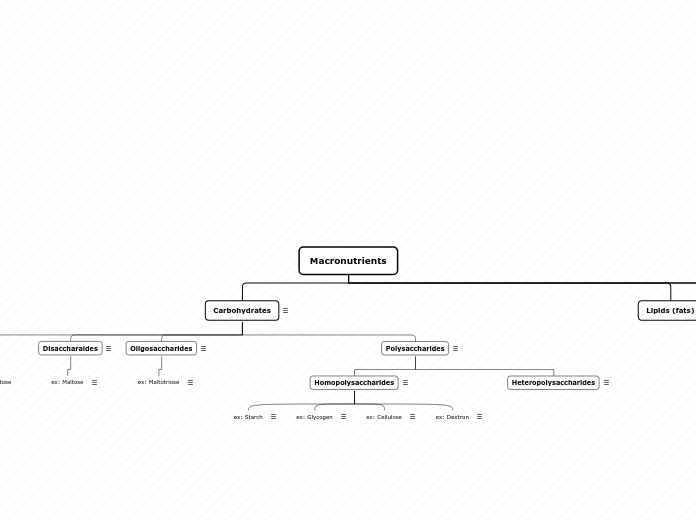Macronutrients
Nucleic Acids
Proteins
Lipids (fats)
Carbohydrates
- Very important source of quick energy.
- Most abundant biomolecules on Earth.
- Serve as important structural components.
Polysaccharides
- More than 20 monosaccharides with 20 bonds, it becomes a Polysaccharide.
- Most carbohydrates in nature are found as polysaccharides.
- Known as Glycans
Heteropolysaccharides
- Contains 2 or more types of different monosaccharides. ex: a long chain of fructose and glucose molecules.
- can be unbranched or branched.
Homopolysaccharides
- Contains only a single type of monosaccharide. ex: only glucose molecules linked together.
- Can be unbranched or branched.
ex: Dextron
- Structural components in bacteria and yeast.
ex: Cellulose
- Structural components in plants. They make up the cell wall.
ex: Glycogen
- Unbranched = Amylose
- Branched = Amylopectin
- Branch points occur more frequently in Glycogen
ex: Starch
- Storage for monosaccharides in plants. It is the main carbohydrate in the human diet.
- Only made up of glucose.
- Unbranched = Amylose
- Branched = Amylopectin
Oligosaccharides
- Short chain of monosaccharides
- Less than 20 monosaccharides linked together.
- A disaccharide can be referred to as an oligosaccharide.
ex: Maltotriose
- Contains 3 glucose molecules.
Disaccharaides
- Made up of 2 monosaccharides
ex: Maltose
- 2 glucose molecules stuck together.
Monosaccharides
- Simple sugars.
- They are the smallest unit that make up carbohydrates.
- They are the building blocks.
Suggested text1Suggested text2
ex: Galactose
ex: Fructose
ex: Glucose









